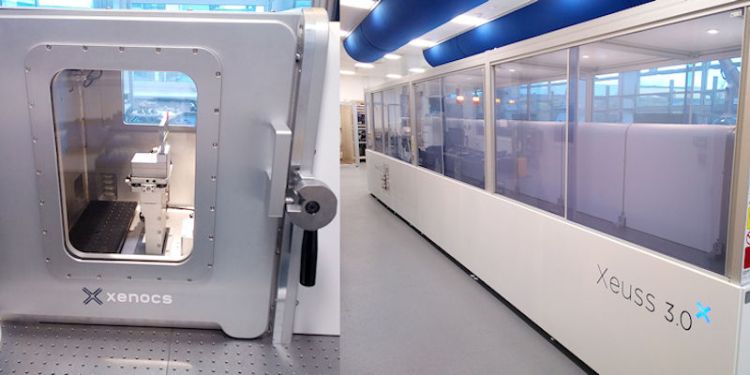Diamond Leeds SAXS Facility
- Overview: The tailored instrument for high-resolving X-ray scattering experiments offers open access to Leeds and other UK-users around the year for the nanostructural fine-analysis of complex soft matter, polymers, bio-materials and advanced solid materials.
- Contact name: Professor Michael Rappolt or Professor Nick Terrill
- Email: M.Rappolt@leeds.ac.uk, nick.terrill@diamond.ac.uk

DL-SAXS is a multi-user and multidisciplinary Small- and Wide Angle X-ray Scattering (SAXS/WAXS) research facility located at Diamond Light Source, on the UK Science and Innovation Campus at Harwell. Established through EPSRC strategic equipment funding, it is operated jointly between the University of Leeds and Diamond. It provides an access point to a state-of-the-art SAXS/WAXS instrument, not only for UoL researchers but also other UK users, providing more than 160 days of experimental beamtime per year. The facility encourages and supports the development and testing of new sample environments for advanced materials research and provides training for the next generation of X-ray scattering experts. DL-SAXS serves both fundamental and applied research, including use for industrial research. It also serves as a hub for strengthening and connecting activities to other UK-SAXS-labs of excellence.
DL-SAXS adds capacity to the UK research landscape and opens new perspectives to the UK for a wide range of science, including, for example, complex soft matter, polymers, bio-materials and advanced solid materials. These are used in industry sectors comprising pharmacy and healthcare, food, fine chemicals, agrochemicals, information and communications technology (ICT), energy, process engineering and manufacturing.
Equipment
DL-SAXS operates a Xenocs Xeuss 3.0 Small- and Wide Angle X-ray Scattering (SAXS/WAXS) instrument, which provides enhanced research capability for high-end characterization of materials on the nanoscale, as well as for in situ and operando experiments under process and synthesis conditions. Strategic emphasis is placed on the development of new sample environments and feasibility testing prior to synchrotron experiments. Novel optics combined with scatterless-slit collimation eliminating parasitic noise facilitate nanoscale structure analysis from 0.1 to 500 nm. The metal-jet X-ray source provides very high photon flux at 9.2 keV (Gallium alloy) and is complemented with an X-ray micro-focus source at 17.5 keV (molybdenum). This not only allows the investigation of a wide range of soft and solid matter (from low to high atomic number), but also facilitates the integration of sample cells equipped with highly absorbing window materials such as high-pressure sample cells.
The facility is linked to the Diamond Leeds collaboration, supporting users in design, application and preparation of SAXS/WAXS experiments with cutting-edge X-ray scattering characterisation at the Diamond Light Source.
Partners and sponsors
The Diamond Light Source Ltd. hosts the new offline SAXS user facility. Jointly bid for by University of Leeds and Diamond, the facility, funded by the EPSRC, offers complementary materials science measurements to those available on I22 SAXS beamline.
Who can use the facility?
The DL SAXS Facility offers free access to any academic user from the University of Leeds as well as to outside higher education institutions. Applications for beamtime are made via the User Administration System (UAS) of Diamond. Depending on the requirements of our industrial users, we offer rapid access and flexible beamtime allocation or mail-in access modes.
Members of staff
Professor Michael Rappolt holds a Leadership Chair of Lipid Biophysics at the School of Food Science and Nutrition at the University of Leeds. He is a leading authority on the use of various small- and wide-angle scattering techniques on investigating the structure, shape and flexibility of model membranes with various, seminal achievements concerning their nanostructural and mechanical analysis.
Professor Sven Schroeder, Bragg Centenary Chair in Engineering Applications, will ensure strategic integration of the DL-SAXS Facility with a wider UK community as Continuous Manufacturing Group Leader in the Research Complex at Harwell and as one of UoL’s institutional leads in the Henry Royce Institute.
Professor Nick Terrill, Visiting Associate Professor in the School of Chemical and Process Engineering and Principal Beamline Scientist I22/DL-SAXS, Diamond. He has led the design, build and exploitation of SAXS beamlines at Diamond and is currently developing ideas for Diamond II. His scientific interests include polymers, colloids and biomaterials, where he has been active in the development of combined techniques to study dynamic structural changes.
Sam Burholt joined the School of Food Science and Nutrition at the University of Leeds in May 2019, working in the Diamond Leeds team after completing a PhD on bio-active self-assembling lipopeptides in the Department of Chemistry at the University of Reading.

